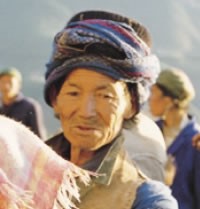Wuding is home to numerous small people groups. Each group wears distinctive dress and is recognized as a separate entity by the local inhabitants. Although the Minglang speak a language related to Sani, they firmly consider themselves a unique tribe. In recent decades, under increasing pressure from large numbers of Han Chinese who have migrated into Wuding, the Minglang have commenced a gradual slide toward assimilation. Some Minglang children now exclusively speak Mandarin.
The Minglang have never possessed a written script of their own, although some of the Minglang Christians are able to read the Pollard script - devised by missionary Samuel Pollard in the early 1900s to help illiterate tribal people read the Bible.
The Minglang observe the traditional Chinese festivals, in addition to several regional Yi celebrations.
In the past the Minglang were animists and polytheists, living in fear and bondage to a wide variety of spirits. Today about half are Christians.
The Minglang (and many other groups in the Wuding area) owe their salvation to the efforts of the Eastern Lipo Christians. "On the banks of the 'River of Golden Sand' in the upper Yangtze watershed between Sichuan and Yunnan provinces live the Yi people.... The Lipos, a Yi sub-group formerly called the Eastern Lisus, have had the gospel for almost half a century. These remarkable mountain people... have used their musical talent to share the good news of salvation and freedom from all demonic control. Old hymns, packed with sound doctrine, were translated and memorized by the early Lipo Christians. Early on they became a singing church which not only preserved but also propagated its faith cross-culturally by singing hymns. Today, because of their witness, there are believers among many neighboring tribes despite the language barriers and lack of Christian literature. The Lipo have reached the Minglang, the Ming Cha, and the Samei peoples living among them." There is a high percentage of Minglang people who profess Christ, but their churches need revival.
Pray for the Holy Spirit to move mightily among the Minglang people, giving them holy lives that will inspire others to follow the Lord of lords.
Pray for the Lord to thrust out Minglang Christ followers to reach the unsaved in Yunnan Province.
Pray for disciples who will disciple others.
Scripture Prayers for the Minglang in China.
Operation China, Asia Harvest, Copyrighted © Used with permission
| Profile Source: Joshua Project |










